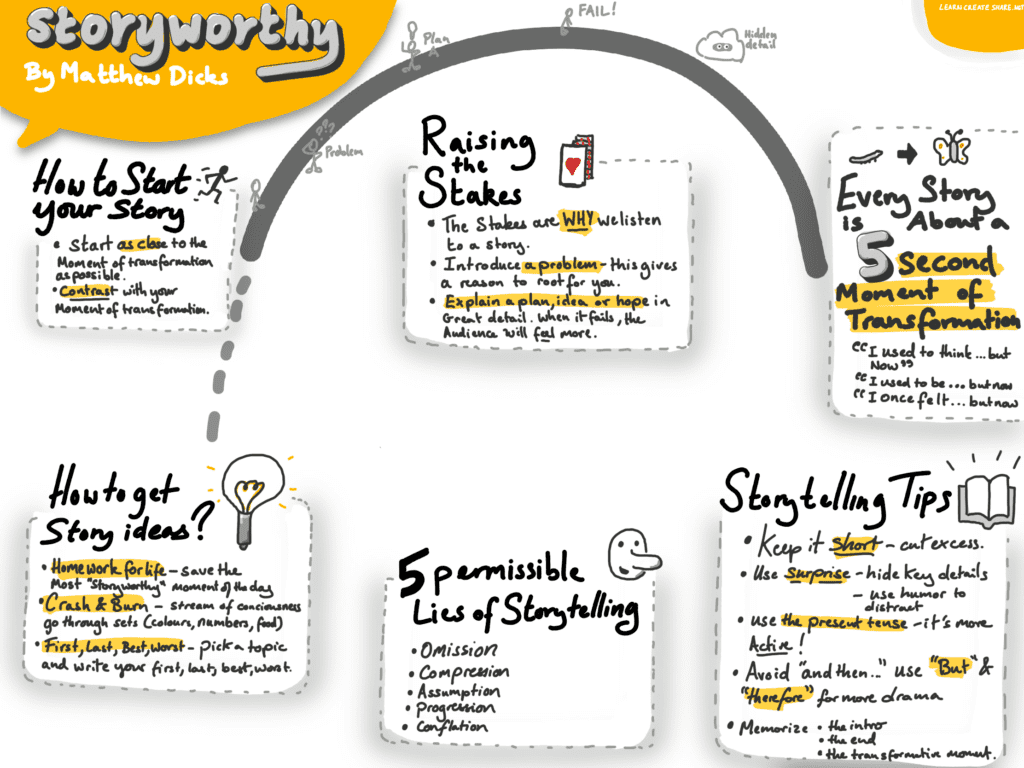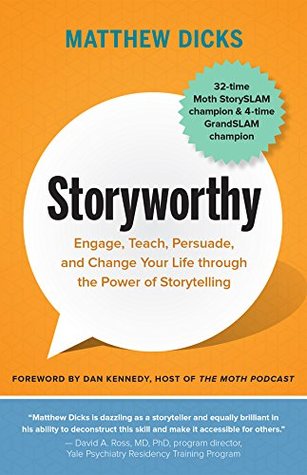Storytelling is powerful. Everyday we make reference to, our influenced by and retell stories that are part of cultural zeitgeist. The allure of storytelling has directed much of my recent reading as well as book summaries (including my recent Storybrand related book summary) but Matthew Dicks book was different.
After seeing Storyworthy in photos of friends desks, in book summaries on other sites and recommending reading lists I finally caved and grabbed a copy.
Best, decision, ever.
Seriously, Storyworthy is a fantastic book on storytelling that gave me fantastic ideas not just for writing and marketing but it has idea that can help us make better track of our lives.
Sketchnote summary of Storyworthy by Matthew Dicks

Key facts
Title: Storyworthy: Engage, Teach, Persuade, and Change Your Life through the Power of Storytelling
Author: Matthew Dicks
Year Published: 2018
ISBN-10: 1608685489

My three key takeaways
- Matt’s activities for finding storyworthy moments have been a great exercises and way to not just get story ideas but keep track of my days better.
- The idea of the start showing the greatest contrast with the moment of transformation was a eureka moment for me. It’s affected my approach to both storytelling and marketing materials.
- The idea of explaining a plan or making a prediction to get people invested, only for it to fail is my final game changing idea. It made me realise how we can create tension just by explaining an idea.
What makes a good story?
Every good story is about a five second moment of transformation. This is the moment when the main character, the storyteller, has a realization and things can’t be the same again.
Every good story is about a five second moment of transformation.
The typical mistakes in story telling including
- Trying to be funny
- Telling a story that has no transformation or depth
- Focusing on crazy stories with rare or unbelievable events.
Some of the best stories and transformations come from small moments of everyday life.
Once you have a good moment of transformation, you just need to make sure every other part of the story directs to that moment of transformation.
A story we can relate to
Great stories have something that we can all relate to. A story about an incredible event few people have experienced sounds impressive, but leaves us the audience disconnected.
This can make stories about big events (like a car crash) more difficult to tell than a story about a moment at an evening meal as they are more relatable.
If you have a story about a huge life event, your moment of transformation needs to be relatable.
How to get ideas for a good story
Matthew shares three main methods to get a good story.
- Homework for life
- Crash and Burn
- First, last, best worst,
Homework for life involves writing down a storyworthy moment from each day. Matthew uses an excel spreadsheet for this as it’s easy to browse through later.
Crash and Burn is what man people know as stream of consciousness writing. You write whatever comes to your mind and follow random trains of thought. To help you get idea, try writing lists (of colours, numbers, food) and see what triggers a memory. After 10 mins of writing, go back over and see if there are any ideas that you could use in a story.
First, last, best, worst again uses categories but this time it’s a bit more intentional. You choose an object and then the first, last, best and worst of that item. I.e. Pizza, First time you ate it, the last time you ate, the best pizza you ever ate and the worst.
How to craft a good story
Every part of the story needs to reinforce your moment of transformation. Start, middle and end. So you should keep the transformation in mind throughout the story.
The importance of the start.
The start of your story needs to set up your transformation and be as close to your moment of transformation as possible.
The start of the story needs to be the greatest contrast between our moment of transformation.
Matt shares the example of Jurassic Park where Alan Grant shows his dislike of Children at the start of the film but by the end of the film he has the children resting on him on the flight away from the island.
Without showing the contrast at the beginning, the moment of transformation is strange.
You may want to write out the before and after of your transformation (i.e. “I was one…but now…”) and then search for a moment that best encapsulated that “before” state.
Starting as close to the moment of transformation also aids us as starting in the action. Don’t include any build up, but start in the action. You want to have momentum from the beginning so the audience feels they are going somewhere.
Don’t include an introductory or expectation setting statement. These ruin the surprise in your story or set unrealistic expectations. For example.
- “Let me tell you about the most incredible moment in my life.” — Now you’ve set extreme expectations)
- “This is a story about” — now the audience is looking for signs of that.
Raising the stakes

The stakes are what keep people listening to a story. While stories about mundane moments can be the most profound, we can raise the stakes to keep a story interesting.
One way is to introduce a problem that needs solving early on. This gives the audience a reason to root for you in the story. Matt call’s this the “elephant” and while the elephant may “change colour” (gain a different view or flavor), it won’t change.
In more practical details, this means your problem may become more intense, or you may solve one aspect but discover another, but you won’t gain a new unexpected problem.
If you do, try to cut out one problem from your story or show how it is related to the original one.
Fortune telling and raising the stakes
Another trick to create extra tension is to explain our plan, idea or hopes in great depth. This helps the listener feel those emotions, gain those hopes and buy into our plan. It even works if the plan makes no sense at all.
We can also make predictions about what is going to happen (even wild crazy ones) and this gets our audience to wonder if they will happen, it can distract from the obvious outcome.
The five permissible lies

There are five types of lies which are okay in storytelling.
- Omission – Cut out what doesn’t matter or extra people who distract from the core parts of your people.
- Compression – It’s important to keep stories moving and short. You can make routes or timelines shorter so it makes the story move faster.
- Assumption – Sometimes we can’t remember the details but we can assume details to make our stories more vivid. Just make sure they are reasonable.
- Progression – we can change the order of events to make them flow better for a story. For example, making people laugh before they cry and placing the transformational moment at the end.
- Conflation – we can put all our emotions on one moment rather than spreading it out over time. Sometimes we have the same realization multiple times and it takes time to stick, by merging it to one, we bundle the emotions together.
The “But” and “Therefore” Rule

The South Park writers says that a story is bad when every scene is connected with a “and then”. This shows that it is the natural flow of events and there’s no drama. We can predict what is going to happen next.
If a scene is linked by “but” or “therefore” it creates more tension and makes the story unpredictable.
Use negatives
Similarly, negatives are better than a positive adjective (I’m not smart vs I’m dumb) as it shows potential.
Using a negative introduces the positive idea while showing we aren’t there yet. As our story is about transformation, we get our audience to hope that the protagonist will change to the positive state.
We can use multiple negatives attributes before ending with a positive. This emphasizes the positive at the end as it stands out more.
“I’m not smart, not handsome and flat broke.”
Exception: Always answer a question with a positive. It’s strange to answer a question with a negative description.
Keep it short
Make sure your story is to the point and tight. There may be extra details that are cool or impressive, but they distract from the story. We need to keep it short. The longer you speak, the better the story needs to be.
SUPRISE!

Surprise is powerful in stories. It keeps people engaged and it is the key for humor as it makes people laugh.
To increase surprise, we need to hide details by distracting the audience.
We can do that with humour or placing key details in a string of other details. If we focus on another detail around the same time, it suggests that detail is more important than the real key detail.
Some previous points can help with our surprises such as
- explaining our hopes and dreams,
- giving detailed plans (that fail)
- showing alternative possibilities
We can ruin surprises by
- including a thesis statement at the start of the story
- not explaining the stakes or a situation
- not including critical information in advance
One challenge is making sure we include critical details so a surprise makes sense, but camouflage them well enough so people don’t predict the outcome.
The present tens is king
Most people tell stories in the past tense as they are about events in the past. But we can also tell stories in the present tense.
“I was on a train” vs “I’m on a train”.
Using the present tense helps the listener to feel like they are in this story at this very moment. We can then use the past tense to provide background information during the story.
Shifting tenses can highlight emotion in a story.
While the past tense can add more distance which is useful for gross moments or moments when you want the audience to have more distance.
It’s tricky and take some practice, but a skilled story teller can switch seamlessly between tenses.
No one likes a bragging story
“I started off great, had a great time, and everything ended perfectly” is the type of story arrogant jocks tell.
We prefer failure stories because we can more easily relate to them.
If you are telling a hero story, you need to either show your negative aspects and give yourself potential to grow or position yourself as an underdog so the audience will root for you.
How to deliver a good story
Matt doesn’t advise memorizing the whole story, just three parts.
- the beginning — make sure you can start the story well
- the end — make sure you nail your moment of transformation and conclusion
- the scenes. — make sure you know where you are going to next.
If you try to memorize everything, you can add extra stress and feel lost when you go off track, but memorizing the key beats will help you have confidence and flexibility.
Grab your copy of storyworthy!
There’s more insights in Matt’s books as well as examples of his own stories. If you want to your own copy, click the button below and find it at your favourite book shop.

Leave a Reply